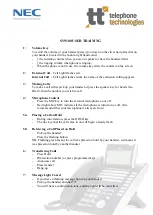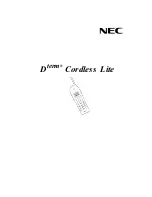
British Telecom Plug
431
A
(Figure 9a)
1 29 To install a telephone set fitted with a British
Telecom plug 431 A terminal connector:
1 ) Check that a master line jack unit is already
installed on the wall, or install one if
necessary. The line jack unit must be fitted
with a capacitor across terminals 2 and 3.
2) Connect the 'B' leg of the master line jack
unit to terminal 2. Connect the 'A' leg to
terminal 5.
3) If more than one telephone set is being
installed on site, connect the system as
shown in Figure 9a.
4) Connect extension bells,
if required,
across terminals 3 and 5. Extension bells
should be of high impedance, nominally 4k
ohms.
Block Terminal 52A
(Figure 9b)
1 30 To install a telephone fitted with a block
terminal 52A:
1) Mount the 8-way block terminal to the wall
skirting with either wood screws or self
tapping screws.
2) Connect the telephone exchange 'A' and
'B' wires to terminals 8 and 5 respectively,
as shown in Figure 9b.
3) If telephone sets are required to be
connected in parallel, all telephones other
than the main instrument should have the
internal bell capacitor, if fitted, out of
circuit. With the exception of the MF
( 1 503) versions, this is achieved by
plugging link SKC inside the telephone
across pins 1 and 2 of PLC. On the MF
( 1 503) instruments, link SKE and pins 1
and 2 of PLE serve this purpose. The line
cord should then be connected as follows:
a) 'B' leg to terminal 5.
b) Bell wire to terminal 6 if required.
c) Earth leg to terminal 7 if required.
d) 'A' leg to terminal 8.
4) Connect extension bells,
if required,
across terminals 6 and 8. Extension bells
should be of a high impedance (typically 4k
ohms).
Western Electric Type Plug
1 31 To install a telephone fitted with a Western
2) Make the following connections:
a) 'B' leg to pin 2.
b) Bell wire to pin 3.
c) Earth leg to pin 4 if required.
d) 'A' leg to pin 5.
3) For parallel operation of telephones fitted
with Western Electric type plugs, para
graph 1 30 3) above applies.
132 After installing the telephone sets, carefully
remove the transparent cover from the telephone
number recess, using a flat bladed tool such as a nail
file. Fit the appropriate label bearing the telephone
number and replace the transparent cover.
OPERATION
Tone Caller
1 33 An adjustable attenuator/volume control is
fitted on the base instrument. Adjust the control as
required, by turning the indented disk on the right
hand side of the base, forward to increse the volume
(i.e. clockwise to increase the volume, when viewed
from the underside).
Dialling
1 34 The instrument is active as soon as the
handset is lifted from its cradle to operate the hook
switch. On hearing the dialling tone, simply press the
push button keys in the required order. If a recall
facility is provided, operation of the
R
(recall) push
button will give either timed break, earth loop or reg
ister recall. After use, replace the handset on its
cradle to operate the hook switch.
MAINTENANCE
135 The use of specially designed integrated cir
cuits have rendered unnecessary many wired-in com
ponents and moving parts. The complete unit is
therefore, for all practical purposes, simple and
robust, and will give many years of trouble-free
service without regular maintenance.
FAULT FINDING
1 36
Any fault suspected in the unit is most likely to
be caused by poor electrical connections. It is
advisable to check that all connections are properly
made. If dialling difficulty is experienced, dismantle
the instrument and check the rubber mat for wear. In
the unlikely event of any other fault, the information
Electric Type Plug:
in this handbook will enable an experienced tech-
1 ) Check that a Western Electric type socket
nician to trace a fault to a suspect area or board. The
is mounted on the wall, or install one if nee-
unit may then be dismantled and the faulty part or
essary.
board replaced.
14
3513 300 05070
















































